
The Battle of Stalingrad was a major battle on the Eastern Front of World War II, beginning when Nazi Germany and its Axis allies attacked and became locked in a protracted struggle with the Soviet Union for control over the Soviet city of Stalingrad in southern Russia. The battle was characterized by fierce close-quarters combat and direct assaults on civilians in aerial raids; the battle epitomized urban warfare, being the single largest and costliest urban battle in military history. It was the bloodiest and fiercest battle of the entirety of World War II—and arguably in all of human history—as both sides suffered tremendous casualties amidst ferocious fighting in and around the city. The battle is commonly regarded as the turning point in the European theatre of World War II, as Germany's Oberkommando der Wehrmacht was forced to withdraw a considerable amount of military forces from other regions to replace losses on the Eastern Front. By the time the hostilities ended, the German 6th Army and 4th Panzer Army had been destroyed and Army Group B was routed. The Soviets' victory at Stalingrad shifted the Eastern Front's balance of power in their favour, while also boosting the morale of the Red Army.
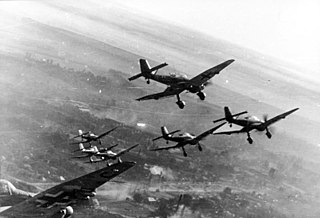
World War II or the Second World War was a global conflict between two coalitions: the Allies and the Axis powers. Nearly all the world's countries—including all the great powers—participated, with many investing all available economic, industrial, and scientific capabilities in pursuit of total war, blurring the distinction between military and civilian resources. Tanks and aircraft played major roles, with the latter enabling the strategic bombing of population centres and delivery of the only two nuclear weapons ever used in war. World War II was the deadliest conflict in history, resulting in 70 to 85 million fatalities, more than half of which were civilians. Millions died in genocides, including the Holocaust of European Jews, and by massacres, starvation, and disease. Following the Allied powers' victory, Germany, Austria, Japan, and Korea were occupied, and war crimes tribunals were conducted against German and Japanese leaders.
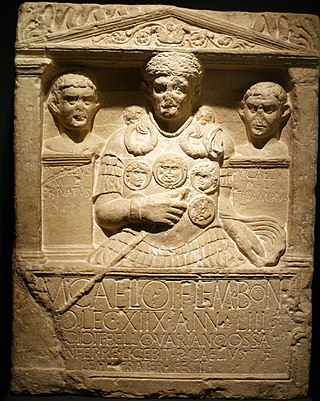
The Battle of the Teutoburg Forest, described as the Varus Disaster or Varian Disaster by Roman historians, was a major battle between Germanic tribes and the Roman Empire that took place somewhere near modern Kalkriese from September 8–11, 9 AD, when an alliance of Germanic peoples ambushed three Roman legions led by Publius Quinctilius Varus and their auxiliaries. The alliance was led by Arminius, a Germanic officer of Varus's auxilia. Arminius had acquired Roman citizenship and had received a Roman military education, which enabled him to deceive the Roman commander methodically and anticipate the Roman army's tactical responses.
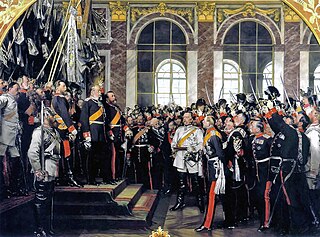
The Franco-Prussian War or Franco-German War, often referred to in France as the War of 1870, was a conflict between the Second French Empire and the North German Confederation led by the Kingdom of Prussia. Lasting from 19 July 1870 to 28 January 1871, the conflict was caused primarily by France's determination to reassert its dominant position in continental Europe, which appeared in question following the decisive Prussian victory over Austria in 1866. According to some historians, Prussian chancellor Otto von Bismarck deliberately provoked the French into declaring war on Prussia in order to induce four independent southern German states—Baden, Württemberg, Bavaria and Hesse-Darmstadt—to join the North German Confederation; other historians contend that Bismarck exploited the circumstances as they unfolded. All agree that Bismarck recognized the potential for new German alliances, given the situation as a whole.

The Western Front was one of the main theatres of war during the First World War. Following the outbreak of war in August 1914, the German Army opened the Western Front by invading Luxembourg and Belgium, then gaining military control of important industrial regions in France. The German advance was halted with the Battle of the Marne. Following the Race to the Sea, both sides dug in along a meandering line of fortified trenches, stretching from the North Sea to the Swiss frontier with France, the position of which changed little except during early 1917 and again in 1918.

The Battle of the Somme, also known as the Somme offensive, was a major battle of the First World War fought by the armies of the British Empire and the French Third Republic against the German Empire. It took place between 1 July and 18 November 1916 on both sides of the upper reaches of the river Somme in France. The battle was intended to hasten a victory for the Allies. More than three million men fought in the battle, of whom more than one million were either wounded or killed, making it one of the deadliest battles in all of human history.
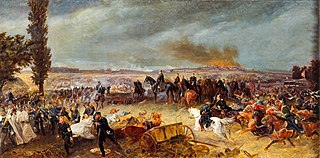
The Austro-Prussian War, also by many variant names such as Seven Weeks' War, German Civil War, Brothers War or Fraternal War, known in Germany as Deutscher Krieg, Deutscher Bruderkrieg and by a variety of other names, was fought in 1866 between the Austrian Empire and the Kingdom of Prussia, with each also being aided by various allies within the German Confederation. Prussia had also allied with the Kingdom of Italy, linking this conflict to the Third Independence War of Italian unification. The Austro-Prussian War was part of the wider rivalry between Austria and Prussia, and resulted in Prussian dominance over the German states.

German East Africa was a German colony in the African Great Lakes region, which included present-day Burundi, Rwanda, the Tanzania mainland, and the Kionga Triangle, a small region later incorporated into Mozambique. GEA's area was 994,996 km2 (384,170 sq mi), which was nearly three times the area of present-day Germany and almost double the area of metropolitan Germany at the time.

The Battle of Caporetto took place on the Italian front of World War I.

Iringa is a city in Tanzania with a population of 202,490 and situated at a latitude of 7.77°S and longitude of 35.69°E. The name is derived from the Hehe word lilinga, meaning fort. Iringa is the administrative capital of Iringa Region. Iringa Municipal Council is the administrative designation of the Municipality of Iringa. Iringa has been one of the coldest regions in Tanzania due to its geographical location but that has attracted a lot of tourists from colder regions abroad especially Western Europe. Iringa also hosts one of Africa’s largest national parks the Ruaha National Park.

Chief Abdallah Mkwavinyika Munyigumba Mwamuyinga, more commonly known as Chief Mkwawa or Sultan Mkwawa, was a Hehe tribal leader in German East Africa, based in Kalenga, Iringa region, who opposed the German colonization. The name "Mkwawa" is derived from Mukwava, a shortened form of Mukwavinyika, meaning "conqueror of many lands".
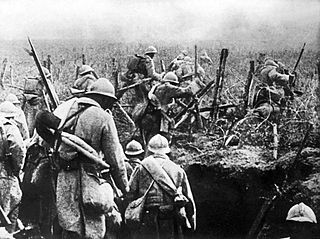
World War I or the First World War, also known as the Great War, was a global conflict between two coalitions: the Allies and the Central Powers. Fighting took place mainly in Europe and the Middle East, as well as in parts of Africa and the Asia-Pacific, and in Europe was characterised by trench warfare and the use of artillery, machine guns, and chemical weapons (gas). World War I was one of the deadliest conflicts in history, resulting in an estimated 9 million military dead and 23 million wounded, plus up to 8 million civilian deaths from causes including genocide. The movement of large numbers of people was a major factor in the Spanish flu pandemic, which killed millions.
The Sangu, at times called Rori, is an ethnic and group based in the Usangu Plain of Chunya District of Mbeya Region, Tanzania. By 1907, their numbers were thought to be about 30,000. In 1987 their population was estimated to number 75,000.

The Vinza are a Bantu ethnic and linguistic group based in Uvinza District of Kigoma Region, Tanzania. In 1987 the Vinza population was estimated to be 10,000. The Vinza people speak the Vinza language, also known as Kivinza, which belongs to the Central Bantu language family. Many Vinza people also speak the Swahili language. The Vinza are also sometimes called Binza and Mabinza.

The Hehe is a Bantu ethnolinguistic group based in Iringa Region in south-central Tanzania, speaking the Bantu Hehe language. In 2006, the Hehe population was estimated at 805,000, up from the just over 250,000 recorded in the 1957 census when they were the eighth largest tribe in Tanganyika. There were an additional 4,023 of them in Uganda in 2014.

The Battle of Grunwald, Battle of Žalgiris, or First Battle of Tannenberg, was fought on 15 July 1410 during the Polish–Lithuanian–Teutonic War. The alliance of the Crown of the Kingdom of Poland and the Grand Duchy of Lithuania, led respectively by King Władysław II Jagiełło (Jogaila), and Grand Duke Vytautas, decisively defeated the German Teutonic Order, led by Grand Master Ulrich von Jungingen. Most of the Teutonic Order's leadership was killed or taken prisoner.
Hehe, also known by its native name Kihehe, is a Bantu language that is spoken by the Hehe people of the Iringa region of Tanzania, lying south of the Great Ruaha River. It was reported to have "Ngoni" features, that is, words of a Zulu-like language introduced when conquered by a Nguni or Zulu-like people in the early 19th century. However, other "Ngoni" speeches seem to have lost most of these distinctive features over the past 150-odd years, the language more resembling those of the neighbouring peoples. In the 1970s, it was estimated that 190,000 people spoke Hehe. There has been some Bible translation. Hehe may be mutually intelligible with Bena.

Tom von Prince was a military officer and plantation owner in German East Africa. He most notably, as a captain in the Schutztruppe, led the first action by German forces in East Africa during World War I by seizing Taveta on 15 August 1914, and was then killed in November at the Battle of Tanga.

The Tanzam Highway leads from Lusaka in Zambia to Dar es Salaam in Tanzania. The highway was built from 1968 to 1973 in several stages and was intended to provide seaport access for Zambia and to expand the transport options for Zambia, Malawi and the then Zaire.

Emil von Zelewski was a German officer of Kashubian descent who served as commander of the Schutztruppe in German East Africa. He led German forces against an uprising by the Hehe people, and was killed at the Battle of Lugalo.


















